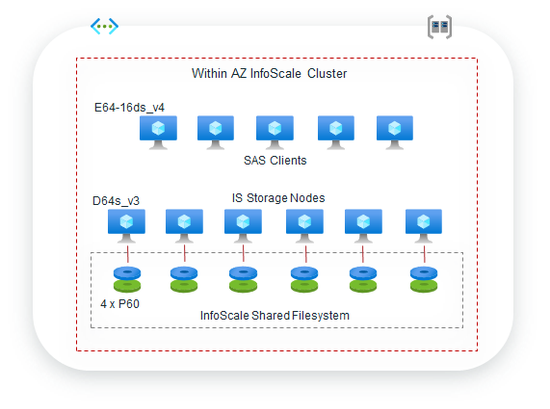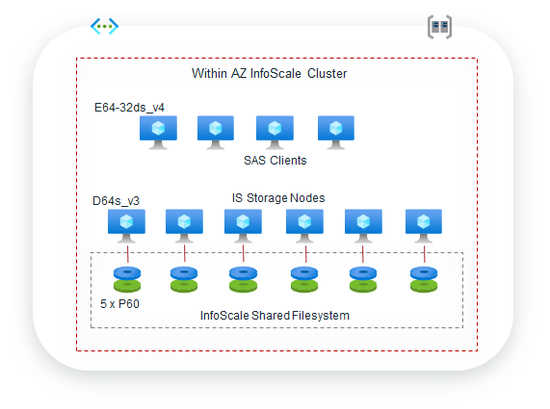SAS recently tested SAS 9.4 on MS Azure instances using InfoScale by Veritas. The results of the testing were very favorable.
Test 1: 40 Physical Cores
The test infrastructure consisted of the 11 MS Azure instances defined like this:
- Five E64-16ds_v4 instances for the SAS clients
- Six D64s_v3 instances for the IS storage – each with four P60 premium drives.
InfoScale 8.0 on RHEL 8.4 was used for the testing.
Architectural Diagram

For the test, the follow tunings were applied:
- On the storage instances:
- Four x 6-way stripped volumes, under volume set (VSET/MVFS)
- VxFS Tuning using /opt/VRTS/bin/vxtunefs
- aligned_flush_enable=1
- discovered_direct_iosz=128m
- write_nstream=96
- read_nstream=96
# /opt/VRTS/bin/vxtunefs -o aligned_flush_enable=1 -o discovered_direct_iosz=128m -o write_nstream=96 -o read_nstream=96 <mount_point>
- File system mounted on all client nodes in clustered mode
# mount.vxfs -o cluster /dev/vx/dsk/<diskgroup>/<vset> <mount_point>
Results
rhel_iotest results:
The 5-node test, with 40 cores total, gave us average 155.17 MB per second per physical core for WRITEs and 144.62 MB per second per physical core for READs.
|
E64-16ds_v4
|
Read
|
Write
|
|
Client 1
|
141.69
|
154.05
|
|
Client 2
|
143.79
|
156.41
|
|
Client 3
|
145.68
|
154.4
|
|
Client 4
|
145.85
|
153.65
|
|
Client 5
|
146.13
|
157.34
|
Test 2: 60 Physical Cores
The test infrastructure consisted of the 10 MS Azure instances defined like this:
- Four E64-32ds_v4 instances for the SAS clients
- Six D64s_v3 instances for the IS storage – each with five P60 premium drives.
InfoScale 8.0 on RHEL 8.4 was used for the testing.
Architectural Diagram

For the test, the follow tunings were applied:
- On the storage instances:
- Five x 6-way stripped volumes, under volume set (VSET/MVFS)
- VxFS Tuning using /opt/VRTS/bin/vxtunefs
- aligned_flush_enable=1
- discovered_direct_iosz=128m
- write_nstream=96
- read_nstream=96
# /opt/VRTS/bin/vxtunefs -o aligned_flush_enable=1 -o discovered_direct_iosz=128m -o write_nstream=96 -o read_nstream=96 <mount_point>
- File system mounted on all client nodes in clustered mode
# mount.vxfs -o cluster /dev/vx/dsk/<diskgroup>/<vset> <mount_point>
Results
rhel_iotest results:
The 4-node test, with 64 cores total, gave us average 129.22 MB per second per physical core for WRITEs and 121.06 MB per second per physical core for READs.
|
E64-32ds_v4
|
Read
|
Write
|
|
Client 1
|
109.86
|
128.46
|
|
Client 2
|
113.68
|
125.27
|
|
Client 3
|
114.28
|
129.57
|
|
Client 4
|
146.44
|
133.59
|
Please note that SAS recommends a minimum of 100 MB per second per physical core for WRITEs and READs.
As you can see, the above InfoScale infrastructure can produce the minimum IO throughput needs of a 40-core and for 64-core SAS Grid application. Additional testing with more cores showed the minimum of 100 MB per second per physical core for WRITEs and READs is met.
Please reach out to Veritas for more details on InfoScale and how to configure it for optimal performance in MS Azure.




